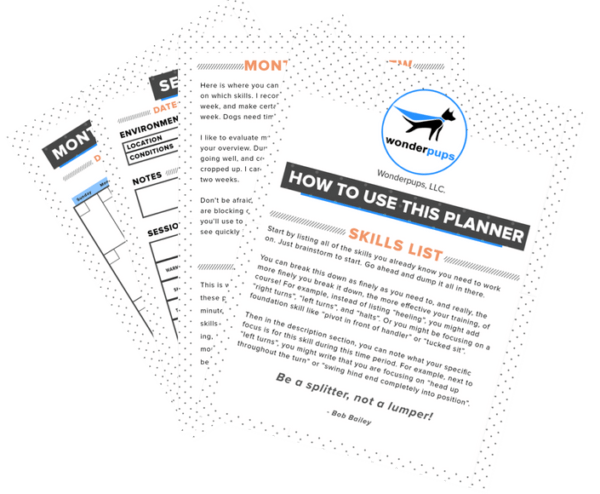Have you ever been in the middle of a training session, and your dog suddenly leaves you to go sniff something?
Or maybe your dog is sniffing the ground for HOURS (subjectively speaking) between each rep before coming back to you?
Did he really catch an irresistible scent, or was that just an opportunistic misdirection? Is the ground just exceptionally smelly here?
Odds are unless some guy shows up and sits down with a full plate of barbecue (which actually happened to me once), the disconnection has little or nothing to do with a specific distraction.
When a fuzzy space arose in your training, your dog suddenly found something Very Important to do elsewhere. (This is exactly what happens when I try to talk to my husband about girl stuff.) There are a couple of key factors we should look at when this happens… and one of the first things we want to check are our basic mechanical skills.
Good mechanical skills are critical to communicating clearly in a training interaction.
Take out all the soft skills (observing, making decisions, “reading” your dog, etc) and our training centers around the core motor skills of being able to effectively mark behavior and deliver reinforcement. Whether that reinforcer is a toy or food… whether that event marker is a click or verbal marker.
These elements must be consistent, accurate and precise.
We need to be able to get the food to the dog with a motion that is smooth, crisp, and predictable. There should be an obvious change of state between Food Not Coming and Food Coming Now. Ideally, the dog should be able to tell from the initial movement of your hand where the food (or toy) is going to appear. And it should be the same every time for that style of reinforcement. Of course, you don’t have to deliver the food the same way every time. But each strategy should *look* the same as you implement it.
If your movements are inconsistent, sometimes dropping the treat at your feet… sometimes 10 yards away. Sometimes a single treat. Sometimes 3 or 4 scatter from your fingers… now we have a significant element of unpredictability. The Chaos Factor. And it tends to slow down our training.
Your dog has a much harder task. He not only has to figure out what behavior you are trying to reinforce… the one you actually are attempting to train… he also has to figure where the hell the food will be and how many pieces he should look for… which often leads to hunting behavior. “Did I get them all this time?” And that’s not helpful.
This is even worse if we are dropping food erratically between reps… when we haven’t even clicked anything.
It’s important to remember that the delivery of the reinforcement contains information just as the timing of the click or event marker does. So the placement of that reinforcement, how exactly is delivered, where the food is and how the dog accesses it, all of that also contains information. So if each treat flies out with a totally different piece of information and there’s no consistency, then all that extra information just becomes static.
Have you ever been talking to someone or maybe even listening to a podcast (not mine), and every third word the speaker says is “um” or “you know” or some similar space-filling, irrelevant sound? It gets distracting, doesn’t it? The irrelevant sounds make trying to filter out the useful information a lot harder!
More information isn’t better. It’s just more. Those randomly dropped treats don’t contain any relevant information. They don’t help the dog figure out what behavior is being reinforced, so they are just noise. It certainly doesn’t help us make progress efficiently, and we can see all kinds of superstitious behavior crop up (like sniffing the ground for possible treats) or accidentally introduce undesired elements in the goal behavior.
But worse than that…
Many dogs will eventually get tired of trying to filter out the static and just change the channel.
What does that look like? The dog may go off in search of simpler reinforcement… often sniffing or even staring off into space.
We want to make the reinforcement process as clear and meaningful as possible so that the dog can focus on learning the goal behavior.
The good news is you aren’t just clumsy forever. We all drop treats some of the time. We just want to work to minimize that so it doesn’t affect our training or our dog’s emotional state. Fortunately, this is a skill we can improve! After all, all behavior is modifiable!
Here are a couple of solutions to clean up your food delivery:
- Warm up. Our hands are important training tools, just like a surgeon or pianist. Take time to stretch out and mobilize your joints. The stiffer your hands are, the more important this is (especially if you spend a lot of time in your “real life” with your hands in a particular position… like typing on a computer). Stiff hands are much more likely to fumble.
- Practice!! Pick 3 specific ways you intend to deliver the reinforcer. Where do you want the food (or toy) to end up? How exactly can you move your arm to make that happen?
- Set yourself up for success. Use a target like a towel on the ground that you can throw toward. Use treats that are easy for you to handle. Use elements in the environment like a wall as a backstop to limit the amount of bounce.
Try a few of these and let me know how it goes!
